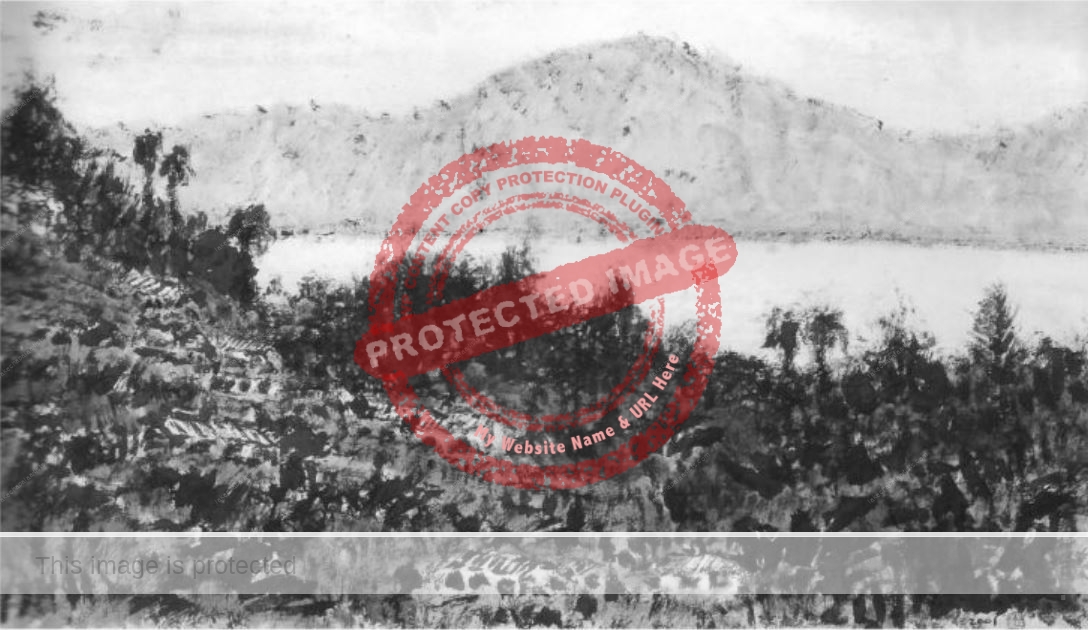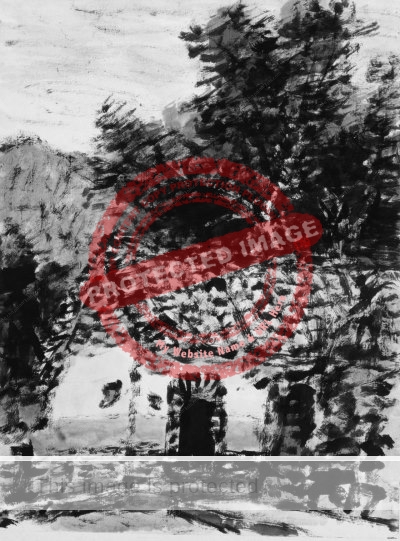Japanese artist Masaharu Shimada, who specializes in sumi-e pen and ink drawings and has held dozens of acclaimed exhibitions in Mexico and his native Japan, lived for several months each year in San Antonio Tlayacapan from 1986 onwards. His exquisite works include numerous evocative monochrome impressionist landscapes of Ajijic and San Antonio Tlayacapan.
Sumi-e, which means black ink painting, developed over several centuries in Japan, after Zen Buddhist monks from China first introduced their deceptively simple techniques and style back in the fourteenth century. Chinese ink is applied to paper using brushes traditionally made of hair, bamboo or feathers.
Born in Nakagyo, Kyoto, in 1931, Shimada graduated from the calligraphy department of Tokyo Gakugei University in 1953 before teaching himself the techniques of sumi-e. He held his first solo show of sumi-e at the Chuokoron-sha Gallery, Tokyo, in 1961.

Masaharu Shimada. 2000. Cerro y lago de Chulavista.
In 1967, he visited Mexico for the first time and stayed six months. Two years later, he produced his first book, México en Sumi-e, published by Mokuji-sha, Tokyo.
He returned to Mexico in 1970 and held a solo show at the University of Guanajuato. In 1972, during his third visit to Mexico, he had a one-person show in Valle de Bravo, in the State of México.
Over the next decade, he revisited Mexico almost every year, before deciding in 1986 to establish a seasonal home in San Antonio Tlayacapan on Lake Chapala.

Masaharu Shimada. 1999. Casa antigua de San Antonio Tlayacapan.
During the course of his long love affair with Mexico, Shimada has produced several more books, including México Pintado en Tinta China and Colección de Pinturas en San Antonio (both published by Editorial Work House, Tokyo) and México Pintado en Tinta China, published in 2003 by Editorial Artes Gráficas Panorama S.A. de C.V. in Mexico City.
Shimada’s major solo exhibitions in Mexico include: University of Guanajuato (1970); Valle de Bravo (1972); Museo Alhondiga de Granaditas, Guanajuato (1978); Galería Arvil, Mexico City (1977, 1979); Casa de Cultura, Guadalajara (1988); Instituto Cabañas, Guadalajara (1989); Museo Pueblo de Guanajuato (1980, 1983, 1988, 1995); Colegio de Michoacán, Zamora (1996); Televisa, Guadalajara (1998); Nikkei Cultural Center, Mexico City (1999); Museo Casa de Arte Olga Costa-José Chávez Morado, Guanajuato (2001); Yakult Cultural Center, Guadalajara (1994, 2002); and Galería Ramón Alva de la Canal, Xalapa, Veracruz (2016).
The 48 sumi-e works Shimada displayed at the last named show included Lago y casa de San Antonio Tlayacapan, Chapala, Jalisco (1995); Fantasía de árbol de nopal (1996); Nopales (1997); and Panorámica de Guanajuato (2000).
The catalog of images from this exhibition can be viewed on issuu.com.
Several chapters of Foreign Footprints in Ajijic: Decades of Change in a Mexican Village offer more details about the history of the artistic community in Ajijic.
Comments, corrections or additional material related to any of the writers and artists featured in our series of mini-bios are welcomed. Please use the comments feature at the bottom of individual posts, or email us.
Tony Burton’s books include “Lake Chapala: A Postcard History” (2022), “Foreign Footprints in Ajijic” (2022), “If Walls Could Talk: Chapala’s historic buildings and their former occupants” (2020), (available in translation as “Si Las Paredes Hablaran”), “Mexican Kaleidoscope” (2016), and “Lake Chapala Through the Ages” (2008).